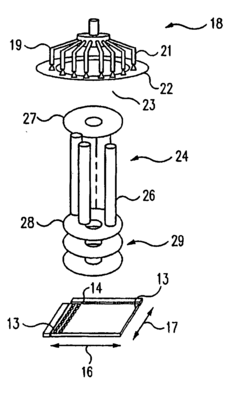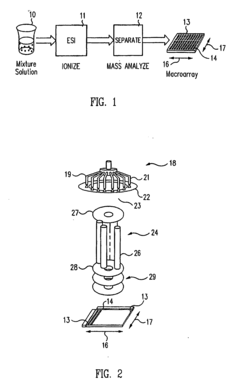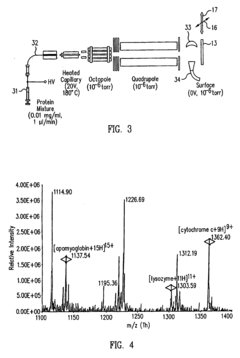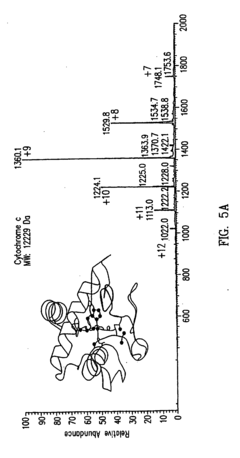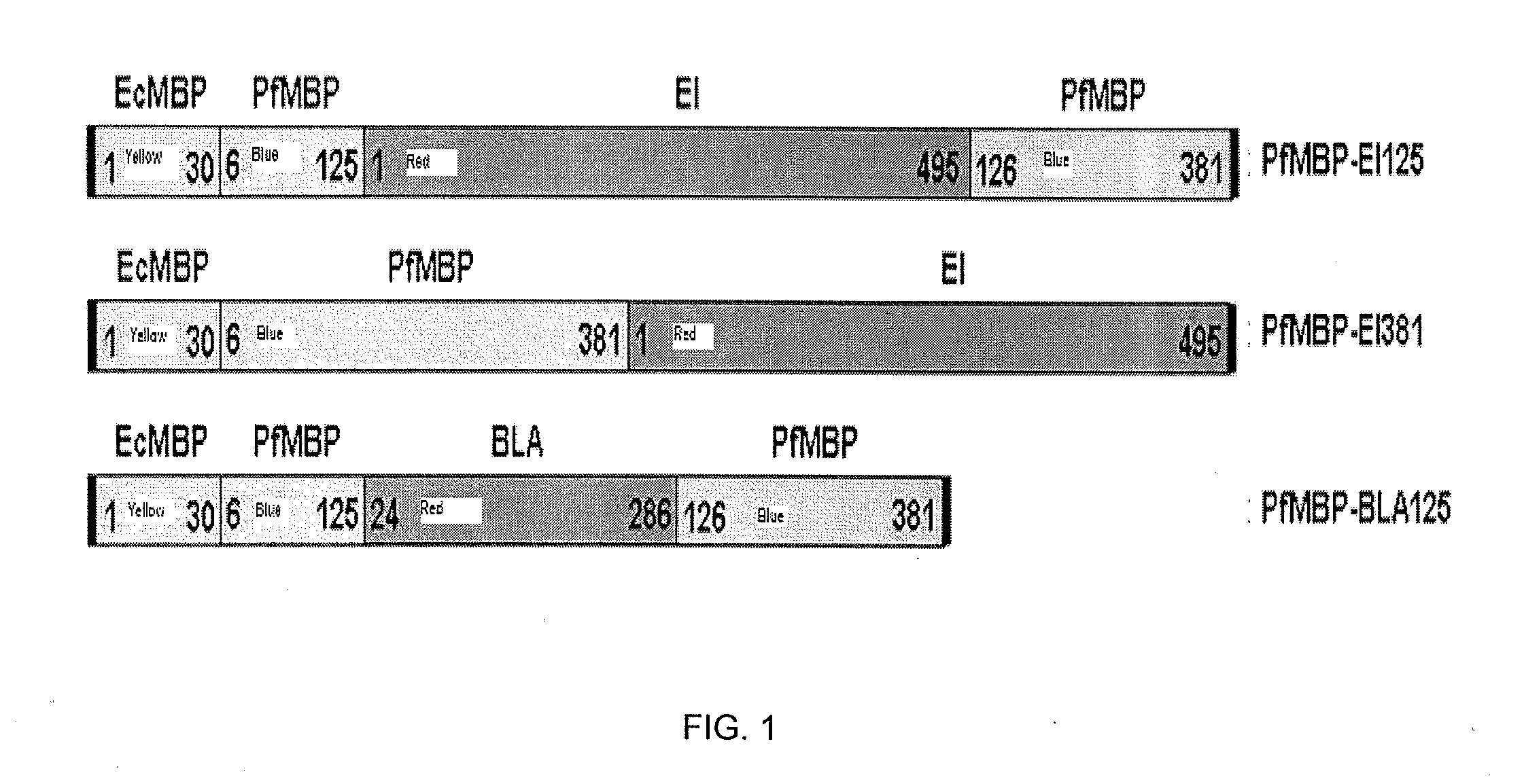Role of Glycerol in Stabilizing Proteins for Biotechnological Applications
JUL 23, 20259 MIN READ
Generate Your Research Report Instantly with AI Agent
Patsnap Eureka helps you evaluate technical feasibility & market potential.
Glycerol-Protein Stabilization Background and Objectives
Glycerol has emerged as a crucial component in protein stabilization, playing a pivotal role in various biotechnological applications. The use of glycerol to enhance protein stability has a rich history dating back to the early days of biochemistry and molecular biology. Initially recognized for its cryoprotectant properties, glycerol's potential in preserving protein structure and function has since been extensively explored and utilized across diverse fields.
The evolution of glycerol's application in protein stabilization has been driven by the increasing demand for robust and reliable methods to maintain protein integrity in biotechnological processes. As the complexity and scale of protein-based technologies have grown, so too has the need for effective stabilization strategies. Glycerol has proven to be a versatile and efficient solution, addressing many of the challenges associated with protein instability in industrial and research settings.
In recent years, the focus has shifted towards understanding the molecular mechanisms underlying glycerol's stabilizing effects on proteins. This has led to more targeted and optimized use of glycerol in various applications, from pharmaceutical formulations to enzyme stabilization in industrial processes. The ongoing research aims to elucidate the precise interactions between glycerol and protein molecules, enabling the development of more sophisticated stabilization techniques.
The primary objective of current research and development efforts in this field is to maximize the effectiveness of glycerol as a protein stabilizer while minimizing potential drawbacks. This includes investigating optimal glycerol concentrations for different protein types, exploring synergistic effects with other stabilizing agents, and developing novel formulation strategies that leverage glycerol's unique properties.
Another key goal is to expand the range of biotechnological applications that can benefit from glycerol-based protein stabilization. This involves adapting glycerol-protein stabilization techniques to emerging fields such as gene therapy, personalized medicine, and advanced biocatalysis. Researchers are also exploring ways to enhance the compatibility of glycerol-stabilized proteins with various delivery systems and production processes.
As the biotechnology sector continues to advance, the role of glycerol in protein stabilization is expected to evolve further. Future objectives include developing predictive models for glycerol-protein interactions, creating tailored stabilization protocols for specific protein classes, and integrating glycerol-based stabilization methods into automated high-throughput protein production and analysis systems. These advancements will contribute to more efficient and cost-effective biotechnological processes, ultimately driving innovation across multiple industries.
The evolution of glycerol's application in protein stabilization has been driven by the increasing demand for robust and reliable methods to maintain protein integrity in biotechnological processes. As the complexity and scale of protein-based technologies have grown, so too has the need for effective stabilization strategies. Glycerol has proven to be a versatile and efficient solution, addressing many of the challenges associated with protein instability in industrial and research settings.
In recent years, the focus has shifted towards understanding the molecular mechanisms underlying glycerol's stabilizing effects on proteins. This has led to more targeted and optimized use of glycerol in various applications, from pharmaceutical formulations to enzyme stabilization in industrial processes. The ongoing research aims to elucidate the precise interactions between glycerol and protein molecules, enabling the development of more sophisticated stabilization techniques.
The primary objective of current research and development efforts in this field is to maximize the effectiveness of glycerol as a protein stabilizer while minimizing potential drawbacks. This includes investigating optimal glycerol concentrations for different protein types, exploring synergistic effects with other stabilizing agents, and developing novel formulation strategies that leverage glycerol's unique properties.
Another key goal is to expand the range of biotechnological applications that can benefit from glycerol-based protein stabilization. This involves adapting glycerol-protein stabilization techniques to emerging fields such as gene therapy, personalized medicine, and advanced biocatalysis. Researchers are also exploring ways to enhance the compatibility of glycerol-stabilized proteins with various delivery systems and production processes.
As the biotechnology sector continues to advance, the role of glycerol in protein stabilization is expected to evolve further. Future objectives include developing predictive models for glycerol-protein interactions, creating tailored stabilization protocols for specific protein classes, and integrating glycerol-based stabilization methods into automated high-throughput protein production and analysis systems. These advancements will contribute to more efficient and cost-effective biotechnological processes, ultimately driving innovation across multiple industries.
Market Analysis for Glycerol-Stabilized Proteins
The market for glycerol-stabilized proteins in biotechnological applications has been experiencing significant growth in recent years. This trend is driven by the increasing demand for stable and functional proteins across various industries, including pharmaceuticals, food and beverages, cosmetics, and industrial enzymes. Glycerol, a versatile and biocompatible compound, has emerged as a key player in protein stabilization due to its ability to maintain protein structure and function under diverse environmental conditions.
In the pharmaceutical sector, glycerol-stabilized proteins are gaining traction in the development of biopharmaceuticals, particularly in the formulation of therapeutic proteins and vaccines. The global biopharmaceutical market, which heavily relies on stable protein formulations, is projected to reach substantial growth in the coming years. This growth is fueled by the rising prevalence of chronic diseases and the increasing adoption of personalized medicine approaches.
The food and beverage industry represents another significant market for glycerol-stabilized proteins. With the growing consumer demand for functional foods and beverages, manufacturers are incorporating stabilized proteins to enhance nutritional value and extend shelf life. The sports nutrition segment, in particular, has shown a strong interest in glycerol-stabilized proteins for their improved stability and bioavailability in protein supplements and ready-to-drink beverages.
In the cosmetics and personal care industry, glycerol-stabilized proteins are finding applications in anti-aging products, hair care formulations, and skin moisturizers. The ability of glycerol to act as a humectant while stabilizing proteins makes it an attractive ingredient for cosmetic formulators seeking to develop innovative and effective products.
The industrial enzyme market is another area where glycerol-stabilized proteins are making significant inroads. Enzymes used in various industrial processes, such as biofuel production, textile manufacturing, and waste treatment, benefit from glycerol stabilization to maintain their catalytic activity under harsh conditions and prolonged storage.
Market analysis indicates that North America and Europe currently dominate the glycerol-stabilized protein market, owing to their advanced biotechnology sectors and stringent regulatory frameworks. However, the Asia-Pacific region is expected to witness the fastest growth in the coming years, driven by increasing investments in biotechnology research and development, as well as the expanding pharmaceutical and food industries in countries like China and India.
As the demand for stable and functional proteins continues to rise across multiple industries, the market for glycerol-stabilized proteins is poised for sustained growth. This trend is further supported by ongoing research and development efforts aimed at optimizing glycerol-based stabilization techniques and exploring novel applications in emerging biotechnology fields.
In the pharmaceutical sector, glycerol-stabilized proteins are gaining traction in the development of biopharmaceuticals, particularly in the formulation of therapeutic proteins and vaccines. The global biopharmaceutical market, which heavily relies on stable protein formulations, is projected to reach substantial growth in the coming years. This growth is fueled by the rising prevalence of chronic diseases and the increasing adoption of personalized medicine approaches.
The food and beverage industry represents another significant market for glycerol-stabilized proteins. With the growing consumer demand for functional foods and beverages, manufacturers are incorporating stabilized proteins to enhance nutritional value and extend shelf life. The sports nutrition segment, in particular, has shown a strong interest in glycerol-stabilized proteins for their improved stability and bioavailability in protein supplements and ready-to-drink beverages.
In the cosmetics and personal care industry, glycerol-stabilized proteins are finding applications in anti-aging products, hair care formulations, and skin moisturizers. The ability of glycerol to act as a humectant while stabilizing proteins makes it an attractive ingredient for cosmetic formulators seeking to develop innovative and effective products.
The industrial enzyme market is another area where glycerol-stabilized proteins are making significant inroads. Enzymes used in various industrial processes, such as biofuel production, textile manufacturing, and waste treatment, benefit from glycerol stabilization to maintain their catalytic activity under harsh conditions and prolonged storage.
Market analysis indicates that North America and Europe currently dominate the glycerol-stabilized protein market, owing to their advanced biotechnology sectors and stringent regulatory frameworks. However, the Asia-Pacific region is expected to witness the fastest growth in the coming years, driven by increasing investments in biotechnology research and development, as well as the expanding pharmaceutical and food industries in countries like China and India.
As the demand for stable and functional proteins continues to rise across multiple industries, the market for glycerol-stabilized proteins is poised for sustained growth. This trend is further supported by ongoing research and development efforts aimed at optimizing glycerol-based stabilization techniques and exploring novel applications in emerging biotechnology fields.
Current Challenges in Protein Stabilization
Protein stabilization remains a critical challenge in biotechnology, particularly for applications requiring long-term storage or exposure to harsh conditions. Despite significant advancements, several key issues persist in maintaining protein stability and functionality.
One of the primary challenges is the prevention of protein aggregation, which can lead to loss of biological activity and potential immunogenicity. Proteins, especially in high concentrations, tend to form aggregates due to intermolecular interactions. This problem is exacerbated by environmental stressors such as temperature fluctuations, pH changes, and mechanical stress during manufacturing and storage processes.
Another significant hurdle is maintaining protein conformational stability. Proteins often undergo structural changes when exposed to different environmental conditions, leading to loss of function. This is particularly problematic for enzymes and therapeutic proteins, where even slight conformational changes can dramatically affect their efficacy and safety profiles.
Oxidative stress poses another major challenge in protein stabilization. Reactive oxygen species can cause irreversible damage to proteins, altering their structure and function. This is especially concerning for proteins with sensitive amino acid residues, such as cysteine and methionine, which are prone to oxidation.
The freeze-thaw stability of proteins is another area of concern, particularly for biopharmaceuticals that require cold chain storage and transportation. Repeated freeze-thaw cycles can lead to protein denaturation, aggregation, and loss of activity, necessitating the development of robust stabilization strategies.
Furthermore, the challenge of maintaining protein stability while simultaneously preserving their biological activity is a delicate balancing act. Many stabilization techniques, while effective in preventing degradation, can inadvertently interfere with the protein's active sites or binding regions, reducing their functional efficacy.
The development of universal stabilization methods remains elusive due to the diverse nature of proteins. Each protein may require a unique combination of stabilizers and conditions, making it challenging to develop standardized approaches across different protein classes and applications.
Lastly, the scalability of protein stabilization methods from laboratory to industrial scale presents significant technical and economic challenges. Techniques that work well in small-scale experiments may not be feasible or cost-effective when scaled up for commercial production, necessitating continuous innovation in stabilization technologies.
One of the primary challenges is the prevention of protein aggregation, which can lead to loss of biological activity and potential immunogenicity. Proteins, especially in high concentrations, tend to form aggregates due to intermolecular interactions. This problem is exacerbated by environmental stressors such as temperature fluctuations, pH changes, and mechanical stress during manufacturing and storage processes.
Another significant hurdle is maintaining protein conformational stability. Proteins often undergo structural changes when exposed to different environmental conditions, leading to loss of function. This is particularly problematic for enzymes and therapeutic proteins, where even slight conformational changes can dramatically affect their efficacy and safety profiles.
Oxidative stress poses another major challenge in protein stabilization. Reactive oxygen species can cause irreversible damage to proteins, altering their structure and function. This is especially concerning for proteins with sensitive amino acid residues, such as cysteine and methionine, which are prone to oxidation.
The freeze-thaw stability of proteins is another area of concern, particularly for biopharmaceuticals that require cold chain storage and transportation. Repeated freeze-thaw cycles can lead to protein denaturation, aggregation, and loss of activity, necessitating the development of robust stabilization strategies.
Furthermore, the challenge of maintaining protein stability while simultaneously preserving their biological activity is a delicate balancing act. Many stabilization techniques, while effective in preventing degradation, can inadvertently interfere with the protein's active sites or binding regions, reducing their functional efficacy.
The development of universal stabilization methods remains elusive due to the diverse nature of proteins. Each protein may require a unique combination of stabilizers and conditions, making it challenging to develop standardized approaches across different protein classes and applications.
Lastly, the scalability of protein stabilization methods from laboratory to industrial scale presents significant technical and economic challenges. Techniques that work well in small-scale experiments may not be feasible or cost-effective when scaled up for commercial production, necessitating continuous innovation in stabilization technologies.
Existing Glycerol-Based Stabilization Methods
01 Glycerol as a protein stabilizer
Glycerol is widely used as a protein stabilizer in various applications. It helps maintain protein structure and function by preventing denaturation and aggregation. The addition of glycerol to protein solutions can enhance their stability during storage and processing.- Glycerol as a protein stabilizer: Glycerol is widely used as a protein stabilizer in various applications. It helps maintain protein structure and function by preventing denaturation and aggregation. The addition of glycerol to protein solutions can enhance their stability during storage and processing.
- Protein stabilization in pharmaceutical formulations: Glycerol is utilized in pharmaceutical formulations to stabilize protein-based drugs. It acts as a cryoprotectant and helps maintain the integrity of proteins during freeze-drying and storage. This application is particularly important for biopharmaceuticals and vaccines.
- Enzyme stabilization using glycerol: Glycerol is employed to stabilize enzymes in various industrial and research applications. It helps preserve enzyme activity and structure, allowing for improved shelf life and performance in different reaction conditions. This is particularly useful in biotechnology and food processing industries.
- Glycerol in protein crystallization: Glycerol plays a role in protein crystallization processes. It can act as a precipitant or additive in crystallization solutions, helping to promote crystal formation and improve crystal quality. This is important for structural biology studies and protein structure determination.
- Combination of glycerol with other stabilizers: Glycerol is often used in combination with other stabilizing agents to enhance protein stability. These combinations can provide synergistic effects, offering improved protection against various stress factors such as temperature, pH, and oxidation. This approach is utilized in diverse fields, including biotechnology and food science.
02 Protein stabilization in pharmaceutical formulations
Glycerol is utilized in pharmaceutical formulations to stabilize protein-based drugs. It acts as a cryoprotectant and helps maintain the biological activity of therapeutic proteins during freeze-drying and storage. This application is particularly important for preserving the efficacy of biopharmaceuticals.Expand Specific Solutions03 Glycerol in enzyme stabilization
Glycerol plays a crucial role in stabilizing enzymes for industrial and research applications. It helps maintain enzyme activity and prevents denaturation under various conditions, such as high temperatures or extreme pH. This property is valuable in biotechnology and biocatalysis processes.Expand Specific Solutions04 Protein stabilization in food and beverage industry
Glycerol is used as a stabilizer for proteins in food and beverage products. It helps prevent protein denaturation and aggregation, improving the texture, shelf-life, and nutritional value of various food items. This application is particularly important in the development of protein-enriched foods and beverages.Expand Specific Solutions05 Glycerol-based formulations for protein storage
Specialized glycerol-based formulations have been developed for long-term protein storage. These formulations often combine glycerol with other stabilizing agents to provide optimal protection against degradation, oxidation, and conformational changes. Such formulations are crucial for preserving valuable protein samples in research and clinical settings.Expand Specific Solutions
Key Players in Biotechnology and Protein Stabilization
The glycerol stabilization of proteins for biotechnological applications is a mature field with significant market potential. The industry is in a growth phase, driven by increasing demand for stable protein formulations in pharmaceuticals, enzymes, and other biotechnology sectors. The global market for protein stabilization is estimated to be in the billions of dollars, with steady growth projected. Key players like Bristol Myers Squibb, DuPont, and Roche Glycart are investing heavily in research and development to enhance protein stability techniques. Academic institutions such as Oxford University and Zhejiang University are also contributing to technological advancements. The competition is intense, with companies like Amgen and AbbVie developing proprietary stabilization methods to gain a competitive edge in this lucrative market.
DuPont de Nemours, Inc.
Technical Solution: DuPont has developed a glycerol-based protein stabilization technology for biotechnological applications. Their approach involves creating a glycerol-rich microenvironment around proteins, which helps maintain their native structure and function. This method utilizes a combination of glycerol and other compatible solutes to form a protective layer, preventing protein denaturation and aggregation[1]. DuPont's technology also incorporates controlled release mechanisms, allowing for sustained protein activity in various industrial and pharmaceutical processes[3]. The company has optimized the glycerol concentration and composition to achieve maximum stabilization effects for different types of proteins, including enzymes and therapeutic antibodies[5].
Strengths: Versatile application across various protein types; enhanced protein shelf-life and activity retention. Weaknesses: Potential cost implications for large-scale production; may require customization for specific proteins.
Genecor, Inc.
Technical Solution: Genecor has pioneered a glycerol-based protein stabilization platform specifically tailored for industrial enzymes. Their approach involves encapsulating enzymes in glycerol-rich matrices, which not only protect the proteins from denaturation but also enhance their thermostability[2]. The company has developed a proprietary formulation that combines glycerol with other polyols and osmolytes to create a synergistic stabilizing effect[4]. This technology has been successfully applied to improve the stability and longevity of enzymes used in detergents, food processing, and biofuel production. Genecor's method also incorporates controlled water activity management to further optimize protein stability in various environmental conditions[6].
Strengths: Highly effective for industrial enzymes; improved enzyme performance in extreme conditions. Weaknesses: May be less suitable for therapeutic proteins; potential limitations in applications requiring low viscosity.
Innovative Glycerol-Protein Interaction Mechanisms
System and method for landing of ions on a gas/liquid interface
PatentInactiveUS20060079002A1
Innovation
- The method involves ionizing sample molecules, separating them by mass and charge using mass spectrometry, and softly landing them onto a substrate, such as a liquid surface, to form an array, which helps in preserving the biological activity and structure of the molecules.
Protein stabilization by domain insertion into a thermophilic protein
PatentActiveUS20100227374A1
Innovation
- The method involves inserting a target protein domain into a thermophilic scaffold protein, specifically using a maltodextrin-binding protein from Pyrococcus furiosus as a stabilizing scaffold, to create a fusion protein that maintains the target protein's activity and specificity while improving its stability.
Environmental Impact of Glycerol in Biotech
The use of glycerol in biotechnological applications has significant environmental implications that warrant careful consideration. Glycerol, a byproduct of biodiesel production, has emerged as a versatile compound in various biotech processes, particularly in protein stabilization. However, its widespread use raises concerns about its environmental impact.
One of the primary environmental benefits of using glycerol in biotech applications is its potential to reduce waste. As a byproduct of biodiesel production, utilizing glycerol in biotechnology helps to create a circular economy, where waste from one industry becomes a valuable resource for another. This approach not only minimizes waste but also reduces the demand for virgin resources, contributing to overall sustainability.
However, the increased demand for glycerol in biotech applications may lead to unintended consequences. If the demand surpasses the supply from biodiesel production, it could potentially drive the production of glycerol through other means, such as petrochemical processes. This shift could negate the environmental benefits and potentially increase the carbon footprint of glycerol production.
The disposal of glycerol-containing waste from biotech processes is another environmental concern. While glycerol is biodegradable, high concentrations in wastewater can lead to oxygen depletion in aquatic ecosystems. Proper waste management and treatment protocols are essential to mitigate these risks and ensure that glycerol-containing effluents do not harm aquatic life or disrupt natural ecosystems.
On the positive side, the use of glycerol in protein stabilization can lead to increased shelf life of biopharmaceuticals and other protein-based products. This extended stability reduces the need for frequent production and transportation, potentially lowering the overall environmental impact of these products throughout their lifecycle.
Furthermore, glycerol's role in cryopreservation of biological materials can contribute to biodiversity conservation efforts. By enabling long-term storage of genetic resources, glycerol indirectly supports the preservation of endangered species and valuable genetic material, which is crucial for maintaining ecological balance and supporting future biotechnological advancements.
In conclusion, while glycerol offers numerous benefits in biotechnological applications, its environmental impact is complex and multifaceted. Balancing the positive aspects of waste reduction and improved product stability against potential risks such as increased production demands and waste management challenges is crucial. As the biotech industry continues to expand its use of glycerol, ongoing research and careful monitoring of environmental effects will be essential to ensure sustainable practices and minimize negative impacts on ecosystems.
One of the primary environmental benefits of using glycerol in biotech applications is its potential to reduce waste. As a byproduct of biodiesel production, utilizing glycerol in biotechnology helps to create a circular economy, where waste from one industry becomes a valuable resource for another. This approach not only minimizes waste but also reduces the demand for virgin resources, contributing to overall sustainability.
However, the increased demand for glycerol in biotech applications may lead to unintended consequences. If the demand surpasses the supply from biodiesel production, it could potentially drive the production of glycerol through other means, such as petrochemical processes. This shift could negate the environmental benefits and potentially increase the carbon footprint of glycerol production.
The disposal of glycerol-containing waste from biotech processes is another environmental concern. While glycerol is biodegradable, high concentrations in wastewater can lead to oxygen depletion in aquatic ecosystems. Proper waste management and treatment protocols are essential to mitigate these risks and ensure that glycerol-containing effluents do not harm aquatic life or disrupt natural ecosystems.
On the positive side, the use of glycerol in protein stabilization can lead to increased shelf life of biopharmaceuticals and other protein-based products. This extended stability reduces the need for frequent production and transportation, potentially lowering the overall environmental impact of these products throughout their lifecycle.
Furthermore, glycerol's role in cryopreservation of biological materials can contribute to biodiversity conservation efforts. By enabling long-term storage of genetic resources, glycerol indirectly supports the preservation of endangered species and valuable genetic material, which is crucial for maintaining ecological balance and supporting future biotechnological advancements.
In conclusion, while glycerol offers numerous benefits in biotechnological applications, its environmental impact is complex and multifaceted. Balancing the positive aspects of waste reduction and improved product stability against potential risks such as increased production demands and waste management challenges is crucial. As the biotech industry continues to expand its use of glycerol, ongoing research and careful monitoring of environmental effects will be essential to ensure sustainable practices and minimize negative impacts on ecosystems.
Regulatory Considerations for Stabilized Proteins
The regulatory landscape for stabilized proteins in biotechnological applications is complex and multifaceted, requiring careful consideration throughout the development and commercialization process. Regulatory bodies, such as the FDA in the United States and the EMA in Europe, have established guidelines and requirements for the use of stabilizing agents like glycerol in protein formulations.
One of the primary regulatory considerations is the safety assessment of glycerol as a stabilizing agent. While glycerol is generally recognized as safe (GRAS) by the FDA, its use in specific protein formulations must be thoroughly evaluated and justified. Manufacturers must demonstrate that the inclusion of glycerol does not adversely affect the safety profile of the final product.
Efficacy is another crucial aspect of regulatory compliance. Developers must provide evidence that the addition of glycerol effectively stabilizes the protein without compromising its intended biological activity. This involves conducting stability studies under various conditions to demonstrate the protein's maintained potency and functionality over time.
Quality control and consistency in manufacturing processes are essential regulatory requirements. Manufacturers must establish robust analytical methods to monitor glycerol concentrations and ensure batch-to-batch consistency. This includes developing and validating appropriate assays for glycerol quantification in the final product.
Regulatory agencies also focus on the potential impact of glycerol on the pharmacokinetics and pharmacodynamics of the stabilized protein. Studies may be required to assess whether the presence of glycerol affects the protein's absorption, distribution, metabolism, or excretion profiles.
Environmental considerations are becoming increasingly important in regulatory assessments. Manufacturers may need to address the environmental impact of glycerol use, including its biodegradability and potential effects on wastewater treatment processes.
Labeling and packaging requirements must also be met, with clear disclosure of glycerol content and any relevant warnings or precautions. This is particularly important for products intended for specific patient populations, such as those with glycerol sensitivities or metabolic disorders.
As regulatory frameworks continue to evolve, companies must stay informed about changes in guidelines and requirements. This may involve ongoing communication with regulatory agencies and participation in industry working groups to address emerging concerns and adapt to new regulatory expectations.
One of the primary regulatory considerations is the safety assessment of glycerol as a stabilizing agent. While glycerol is generally recognized as safe (GRAS) by the FDA, its use in specific protein formulations must be thoroughly evaluated and justified. Manufacturers must demonstrate that the inclusion of glycerol does not adversely affect the safety profile of the final product.
Efficacy is another crucial aspect of regulatory compliance. Developers must provide evidence that the addition of glycerol effectively stabilizes the protein without compromising its intended biological activity. This involves conducting stability studies under various conditions to demonstrate the protein's maintained potency and functionality over time.
Quality control and consistency in manufacturing processes are essential regulatory requirements. Manufacturers must establish robust analytical methods to monitor glycerol concentrations and ensure batch-to-batch consistency. This includes developing and validating appropriate assays for glycerol quantification in the final product.
Regulatory agencies also focus on the potential impact of glycerol on the pharmacokinetics and pharmacodynamics of the stabilized protein. Studies may be required to assess whether the presence of glycerol affects the protein's absorption, distribution, metabolism, or excretion profiles.
Environmental considerations are becoming increasingly important in regulatory assessments. Manufacturers may need to address the environmental impact of glycerol use, including its biodegradability and potential effects on wastewater treatment processes.
Labeling and packaging requirements must also be met, with clear disclosure of glycerol content and any relevant warnings or precautions. This is particularly important for products intended for specific patient populations, such as those with glycerol sensitivities or metabolic disorders.
As regulatory frameworks continue to evolve, companies must stay informed about changes in guidelines and requirements. This may involve ongoing communication with regulatory agencies and participation in industry working groups to address emerging concerns and adapt to new regulatory expectations.
Unlock deeper insights with Patsnap Eureka Quick Research — get a full tech report to explore trends and direct your research. Try now!
Generate Your Research Report Instantly with AI Agent
Supercharge your innovation with Patsnap Eureka AI Agent Platform!
